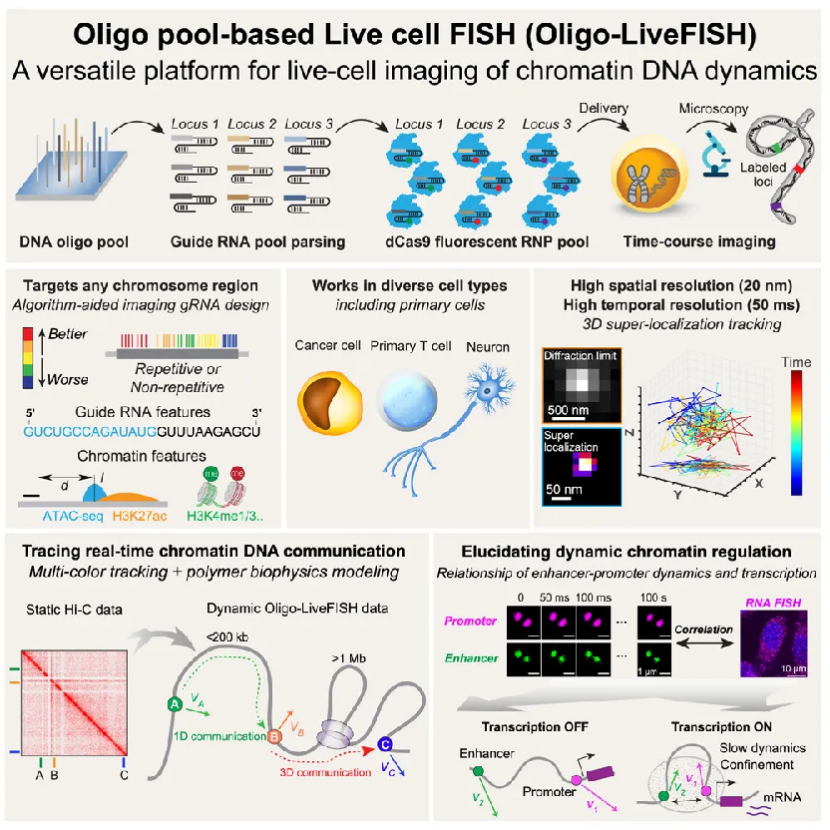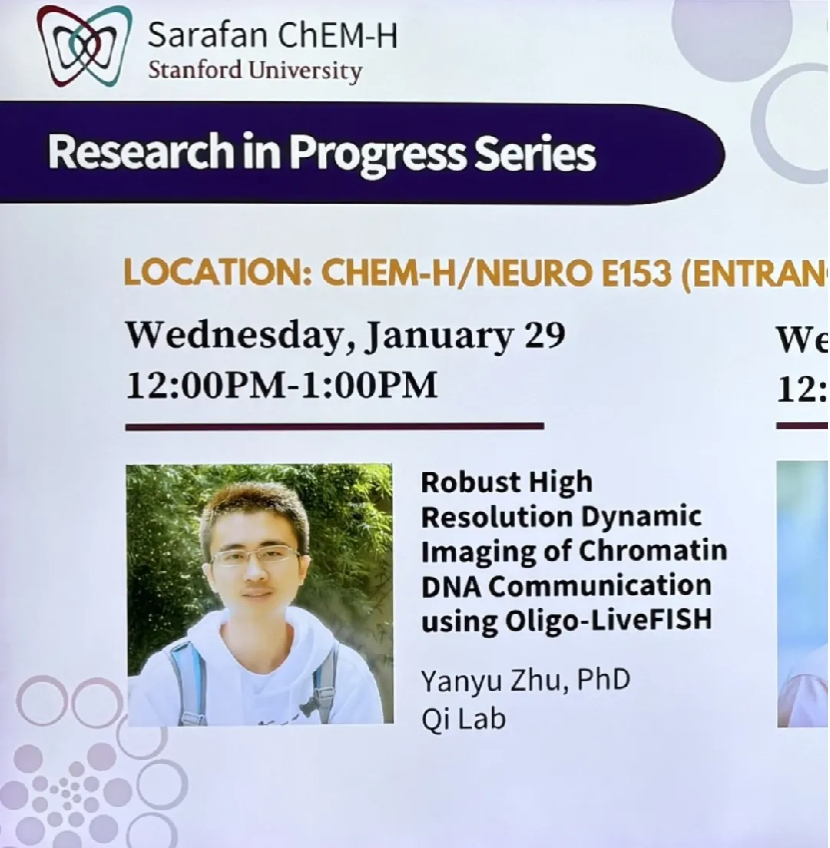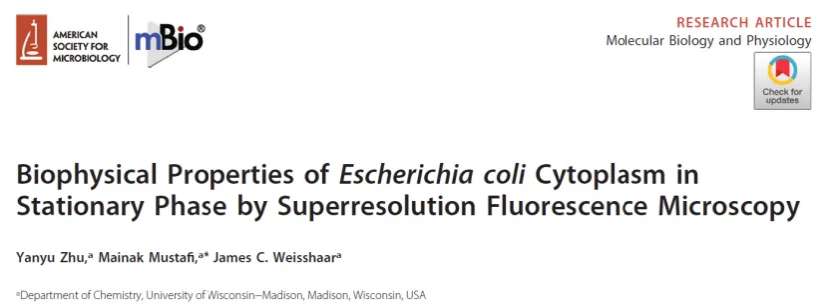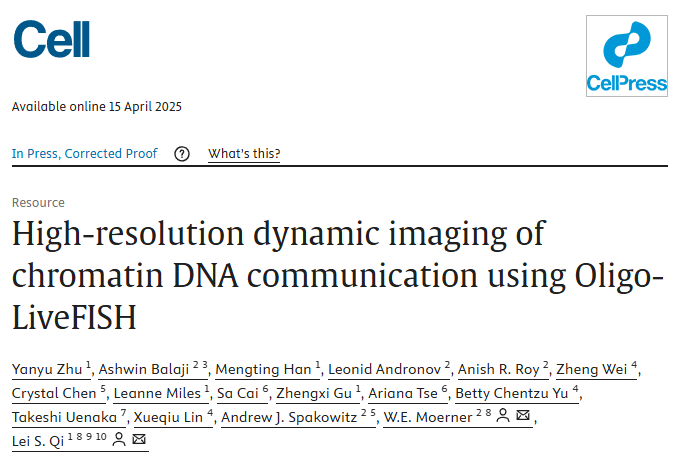Peking University, June 05, 2025: In a groundbreaking advancement in genomic science, Zhu Yanyu, a PKU alumnus graduating in 2015 from Peking University's College of Chemistry and Molecular Engineering and now a researcher at Stanford University, has led the development of a novel live-cell imaging technology that captures the subtle, dynamic interactions of DNA in living cells—essentially allowing scientists to "hear" DNA's quiet communication for the first time. The technology, Oligo-LiveFISH, was recently published in
Cell under the title "High-resolution dynamic imaging of chromatin DNA communication using Oligo-LiveFISH."
A New Window into the Genome
The structure and behaviour of the eukaryotic genome are central to gene regulation and cellular function, with abnormalities in chromatin dynamics linked to diseases such as cancer and neurological disorders. Traditional methods, such as fixed-cell imaging and sequencing, offer only static views, just like photographing a speeding train. Recognizing that life is fundamentally dynamic, Zhu set out to capture the temporal evolution of DNA architecture in real time.
Oligo-LiveFISH rises to this challenge by integrating CRISPR-based genomic targeting with advanced fluorescent labelling, allowing for the real-time tracking of both repetitive and non-repetitive DNA sequences in living cells. When combined with 3D super-localization microscopy, it provides an unprecedented level of detail in observing chromatin dynamics.
Zhu describes the moment of discovery as unforgettable, "To witness non-repetitive DNA sequences move inside a living T cell or neural cell was like seeing shimmering lights in the depths of the universe. That flicker revealed not only the motion of molecules but the beauty of life's hidden language."

Graphical summary of Oligo-LiveFISH
From Visualization to Interpretation
More than just a visual breakthrough, Oligo-LiveFISH paves the way for understanding the "secret language" of DNA. Zhu and his team discovered that DNA interactions follow consistent patterns. They proposed two modes of chromatin communication: 1D cis-communication and 3D trans-communication.
They observed that gene activity directly affects these interactions. For example, when the FOS gene is activated, the enhancer and promoter regions draw closer and move slower, indicating a more stable transcriptional state. This supports the idea that transcription not only involves biochemical signals but also spatial and mechanical orchestration within the nucleus.
"In simpler terms," says Zhu, "it's as though when genes are switched on, the regulatory sequences gather, slow down, and begin ‘talking’."
The implications of Oligo-LiveFISH are vast. Its ability to work in primary cells—such as those derived from patients—could revolutionize how scientists study disease mechanisms. For conditions rooted in chromosomal structural abnormalities, this technology enables direct, dynamic observation, offering new insights into diagnosis and potential treatments.
Zhu emphasizes the interdisciplinary nature of the success. His team includes Professor Stanley Qi, known for pioneering CRISPR-based molecular tools; Nobel laureate W.E. Moerner, a leader in single-molecule fluorescence microscopy; Professor Andrew Spakowitz, an expert in polymer physics; and Professor Lin Xueqiu, a computational biology specialist. Their combined expertise created a synergy that transformed a complex idea into a tangible tool.
"I’ve learned so much from these mentors and colleagues. The transition of Oligo-LiveFISH from concept to reality was only possible through such collaboration," Zhu reflects.

Zhu Yanyu’s presentation at Stanford University
The Winding Road of Scientific Discovery
Zhu’s journey was anything but linear. Originally interested in theoretical physics and mathematics due to his strong performance in high school math competitions, his interests gradually shifted during his doctoral studies toward the enigmatic world of gene regulation and chromatin dynamics. This pivot, he says, was catalysed by exposure to cutting-edge research and serendipitous academic conversations.

Visit to the University of Texas at Austin during his doctoral studies
His interdisciplinary background in mathematics, optics, and chemistry proved invaluable. Yet the path was not without setbacks. Shortly after the Oligo-LiveFISH project was launched, a hand injury forced him to take months of medical leave, testing his resolve.
To cope with the challenges of research, Zhu found solace in literature. Works such as
The Hunchback of Notre-Dame and
Romance of the Three Kingdoms gave him emotional and intellectual depth, while Chinese classics like
Zhuangzi and
Su Dongpo’s Biography offered philosophical grounding. "Books that once seemed obscure began to resonate deeply during difficult moments," he shared. "It taught me to embrace complexity and avoid black-and-white thinking."
Looking Ahead
As AI and life sciences converge, Zhu is optimistic about the future. "There are so many unanswered questions in biology. With the right tools and perspective, we are getting closer to decoding the mysteries of life."

Zhu Yanyu as first author in articles published on PNAS and mBio
From his roots at Peking University to the forefront of global research, Zhu Yanyu exemplifies the power of curiosity, resilience, and cross-disciplinary thinking. As he continues to listen to the whispers of DNA under the microscope, he remains a seeker of light in the intricate universe of the cell.
Read more about Zhu Yanyu's research: www.sciencedirect.com/science/article/pii/S0092867425003502?via%3Dihub
Written by: Tang Xiao Tong, Chris
Edited by: Rachel Lee, Chen Shizhuo
Source: PKU News (
Chinese)




